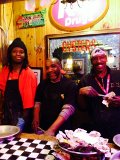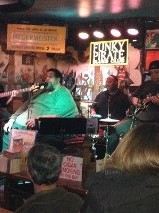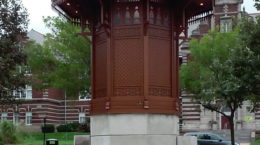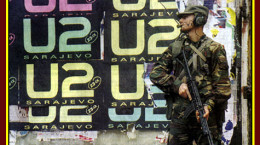In the immediate aftermath of #Katrina, many around America blamed the death and destruction on New Orleans and its residents – some asked should the US simply abandon New Orleans? The pretext was that the city was below sea level and more exposed to such natural disasters; but too frequently the underlying motive was the discomfort with the Big Easy, sometimes known as the Crescent City, as a city of excesses — too much indulgence, too much was allowed that was prohibited by someone’s moral code, too much gay, too much intermixing or simply too much freedom that some saw as subversion. It was as if the Taliban had blown in with the storm and judged the destruction as the wrath of an angry God.
The Revulsion and Fear of the Freedom?
Tagged the Big Easy, it is true that New Orleans is a small city with an excess of culture, as well as indulgence. Like another small city, Sarajevo, it punches way above its weight when producing art, film and music and history – frequently besieged by intolerance with diversity fending off the barbarian impulses and culture feeding the starving. The history of New Orleans is one of complexity, from Empires seeking to make it their own, to residences where rich masters kept their mixed-race concubines. It is not always to be proud of including the “New Orleans Massacre” , where soon after the war racist mobs killed hundreds of peaceful demonstrators white and black, including many US Army Veterans who had defended the Union then seeking the right to vote for all in the post Civil War America. New Orleans frequently set the trend, only to see it subdued.
Like the music that has been birthed form its loins, New Orleans frequently is the chaos of jazz and the melancholy of the blues. It gives birth to hope and rebirth. New music is constantly given exposure, like Zydeco, a mixture of Cajun and local African-American influences. Tradition at times may appear like a fortress wall, but the new is a complement to the old in New Orleans, from the moneyed families of the Garden District to the artists working the well holes of the French Quarter. Racial, religious, economic and sexual orientation diversity mat be viewed as a product of tolerance; but it is also that which allows the production of New Orleans’ most important product, culture, the type to which we travel and also exported. Of course, that is what offends and perhaps scares some in greater America, and why they project New Orleans as an American version of Sodom and Gomorrah.
Playing the Orchestra, but the Music and Instrument of Our Inclination:
We have been to the “Queens’ Parade” on Mardi Gras morning where we were enthralled by some of the most beautiful girls, who were not women. That did not make me gay even as we danced with other men and women in the streets. The New Orleans Jazz & Heritage Festival delivered some of the greatest exhibition of music on a global level but that did not mean that I wanted to become a musician – or if I did, I could opt to be the drummer rather than horn player. The architecture of New Orleans instills a serenity as well as excitement that drips the sweat of life, but it does not mean that America or the globe needs to be built on the model of New Orleans. However, America and the world need cities like New Orleans and Sarajevo that store culture and also challenge the conformity. (Read: “The Decadence of Persecuting Deviance“)
Susan (Walter) Sacirbey and I are probably a bit biased when it comes to New Orleans. We both went to university there, met and fell in love, with the city and each other. Moreover, it has been part of our education, and enhanced respect for difference, moving beyond the flaws and failures and reaching for new heights. New Orleans is gritty and at times gripped by corruption, income inequality and police brutality but it is a city of beauty where the young and old, rich and poor, black and white rub — press in to consume life. It is a city unapologetic for its contradictions but more free of the hypocrisy than any of its neighbors. It is sometimes seen as a little sister to New York and San Francisco, but more accurately it is part of a trinity, with Key West as the hot son, or daughter!
Big Easy, a Rising Tide!
When Susan and I returned to New Orleans, soon after Katrina, New Orleans was a wounded city. However, even within a couple of years of the destruction, the phoenix could be seen rising. The culinary legends, many who feed the hungry including Drago’s, in the immediate aftermath of Katrina, were back to creating in the kitchen. Musicians from around the US were flooding in, even if it meant playing to largely empty houses. Big Al Carson, whose 600+ frame had to be rescued by Katrina, swayed like a water bed as he sang at Lafitte’s Funky Pirate Lounge. All of us are subject to stereotyping, and I saw in his blues a man robbed of love by the weight of his own body. That night though I was informed by chance that Big Al would have to end his set early because he was to marry the next morning, his longtime love. If we could not see the Mecca of music reborn, it was already beyond the Requiem that many had sought to play for the City.
Just recently upon another visit to New Orleans, the city had moved from rebirth to living. Not only were the music halls, restaurants and bars full, but entrepreneurship had taken root. Housing was now in short supply, not just from Katrina but also so many pioneers moving into the city seeking artistic and/or economic fortune. Tulane, Loyola, (world class centers of learning,) and the other universities of the City were in demand, as a new generation saw the City and its rebirth as part of the education.
“They Hate us for Our Freedom”?
There were still problems, and efforts as the “Road Home Program” still had returned less than 20% of the inner city population in the Ninth Ward – a poorer section of the city but where the homes were mostly owned by generations of freed slaves. Contrary to prejudice, the Ninth Ward suffered from being the lowest point in the city with the poorest construction material rather than a population too lazy to work or evacuate. (The Mississippi coast, which suffered similar death and destruction was not victimized by the same prejudice for Katrina, and after Sandy hit the New Jersey and New York coasts many of us learned how indiscriminate natural catastrophe can be.) (See: “Linked by Tragedy of Disaster – Revived by Music.”) Most of the residents of the Ward did not have a car in a city where it was an unnecessary luxury, they could not leave behind extended, close knit families and were the working poor who provided the grist for the Big Easy restaurants and hotels.
The Ninth Ward also gave birth and life to many of New Orleans’ great musicians, artists and athletes (many of whom I had the opportunity to play with during the renaissance of Tulane football in the 1970’s.) Without the Ninth Ward, the restaurants and hotels still function with new cheap labor, but how will New Orleans replace such artists who are born from within, as Louis Armstrong, Pete Fountain, The Neville Brothers, Radiators, or our favorite James Rivers, (who transforms the bagpipes to jazz in a manner that cannot be imagined until you see it, like an electric guitar in a mosque – which could only happen in New Orleans – (Hear & see: “James Rivers Jazz Bagpipes – Fat Harry’s New Orleans.”
New Orleans is connected to the rest of the US by the Mississippi River, and its port is perhaps the most tangible link to other parts of the country. However, it is not the place where we seek safe harbor but the place where sails are are unfurled to seek and catch the wind of the creative. I’m not certain if New Orleans cares what much of America thinks or decrees about its existence – those who are nurtured by it will come or love it from afar. For all those that respect New Orleans for its liberating effect, there are some who “hate it for its freedom.” The Taliban- like thinking will seek its conversion, or if not, destruction, and undoubtedly there will be another hurricane which some will insist was divine judgment. The Big Easy is not a place about which one can feel neutral, as it does compel passion. The more critical question though is can America survive as we know it without New Orleans?
 PHOTO: Le bon temps roulet at the Blind Pelican with oyster shuckers Larry, Keith, and Eddie)
PHOTO: Le bon temps roulet at the Blind Pelican with oyster shuckers Larry, Keith, and Eddie)
@MuhamedSacirbey
Contributing – Susan Sacirbey





